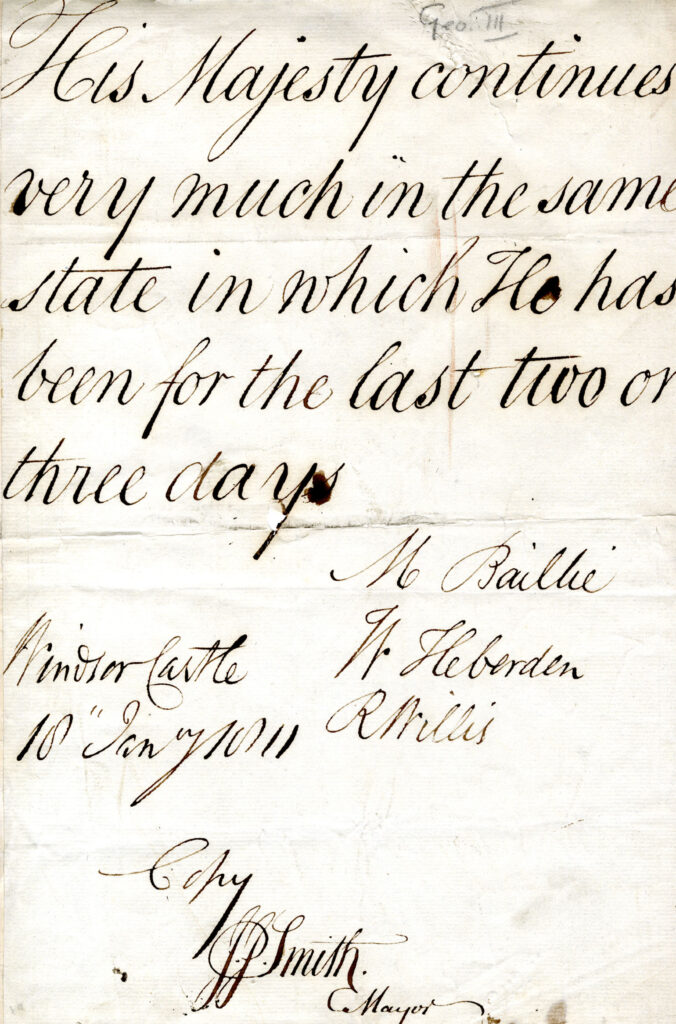The story of King George III’s illness, the repeated bouts of mental instability and derangement from which he suffered from 1788 until the end of his reign, known variously as “the Royal Malady” or “the madness of King George”, is a familiar one.
This bulletin, carrying the latest news on the status of George III’s illness, was issued from Windsor Castle by his doctors and physicians on 18th January 1811, during his final and longest bout of illness and just a few months after his final public appearance at a reception at Windsor.

Bulletins on the king’s health were issued throughout his illness and were intended for public consumption as well as for the eyes of the queen and her council. At this stage the bulletins were being issued daily and deliberately lacked any real or valid detail about the king’s health, being designed to allay alarm rather than to record medical facts and to protect the dignity of the king as well as the feelings of the queen and the royal family. This bulletin, therefore, is a typical example of its type.
It is signed by Matthew Baillie, physician-extraordinary to the king, William Heberden the younger, the king’s physician-in-ordinary, and Robert Willis, who specialised in the treatment of mental disorders. Although the bulletin carries the signatures of all three men, it is known that, by this stage, the royal physicians had been ordered by the queen’s council to leave the daily management of the king’s illness to specialist “mad-doctors” and that to this task the council had appointed John and Robert Willis, sons of the reverend Francis Willis who owned a private asylum and who had been credited with bringing about the king’s recovery from his first bout of illness in 1789.
The Willises favoured the use of repressive and coercive forms of treatment such as the use of the strait-jacket and restraining chair, both of which the king was subjected to, as well as enforced confinement and a strict medical regime to bring down his “fever” and “turbulent spirits”, including vomits, purges, bleeding, blistering, the application of leeches and regular doses of medicine. During the king’s last illness both Baillie and Heberden sounded strong objections to the methods of treatment handed out to him by the Willis brothers, but were ignored.
At the time this bulletin was issued, the king had relapsed midway through the previous month and had been very ill over Christmas and New Year. The following month, he would be declared mentally unfit to rule and his eldest son, the future George IV, would be appointed Prince Regent to rule in his place. Thereafter the king would spend the last ten years of his life in a twilight world, deprived of visitors, conversation and outings under the Willises’ regime, losing his sight and growing increasingly deaf, until his death at Windsor on 29th January 1820.
Although George III’s symptoms were identified as insanity by contemporary doctors, it is now widely held that he was in fact suffering from the rare hereditary blood disorder porphyria. A classic physical symptom of porphyria is deep red or purple coloured urine, and this was found to be evident throughout the notes and observations contained in the journals and correspondence of the king’s physicians when they were re-examined in the 1960s. Furthermore, in its acute form, porphyria is known to produce neurological damage and mental instability. Further research in 2005 concluded that the king’s porphyria attacks were quite possibly brought on by a build-up of arsenic in his system (tests on a sample of his hair showed it to contain over 200 times the toxic level), thought to have been caused by one of his medicines, James’ Powder. The Powder, which, tragically, was administered to him several times daily, was made from antimony which in turn contains significant amounts of arsenic.
The bulletin is contained in a collection of medical manuscripts donated to the library by Professor Pybus (1883-1975) who donated his private collection on the history of medicine, including books, manuscripts, engravings, portraits, busts, bleeding bowls and research notes, to the University Library in 1965.
